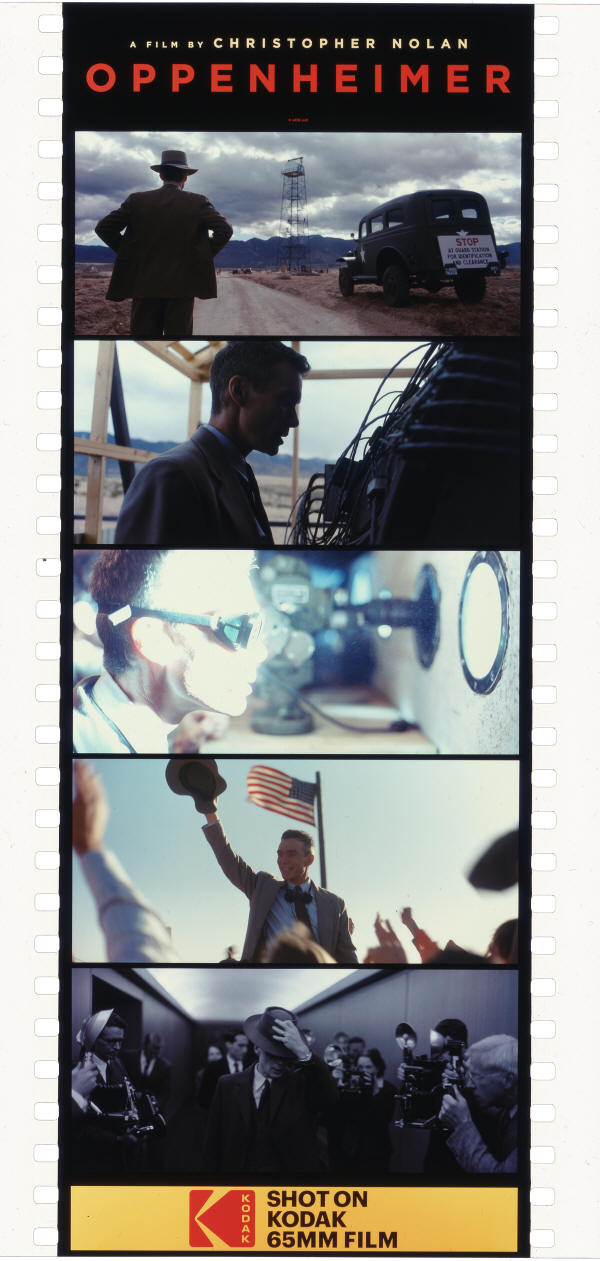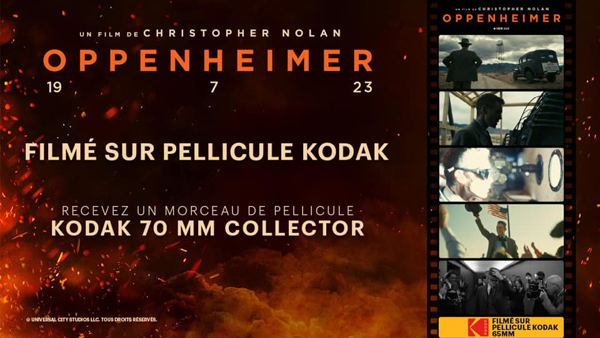About "Oppenheimer" and Large Format |
Read more at in70mm.com The 70mm Newsletter |
| Written by: Universal Pictures | Date: 16.07.2023 |
 OPPENHEIMER PREMIUM LARGE FORMATS OPPENHEIMER PREMIUM LARGE FORMATSIMAX 70mm Select IMAX theatres will be offering the IMAX Experience featuring 15 perf/70mm film projection which combines the brightest, clearest images at 10 times the resolution of standard projection formats, with powerful, laser-aligned digital sound and customized theatre geometry to create the world’s most immersive movie experience. 70mm film 5 perf/70mm film offers a brighter, clearer image, with 3 times the resolution of standard projection formats, using the process of projecting light through celluloid to deliver clear images in rich analog color with state-of-the-art digital sound. 35mm film 35mm anamorphic film screenings project light through the entire 35millimeter frame to deliver clear, high resolution images with rich analog color combined with state of the art digital sound in most locations. IMAX Digital Cinema IMAX digital projection uses projectors with sub-pixel alignment to produce clear, high contrast images, with powerful, laser-aligned digital sound and customized theatre geometry, creating the world’s most immersive digital movie experience. Digital IMAX packages are available in 1.90:1 aspect ratios as well as 1.43:1 for certain dual laser setups. Dolby Cinema The Dolby Vision projection system consists of dual 4K laser projectors capable of delivering up to 108 nits (31 Foot Lamberts) of full-screen brightness—resulting in a richer, more detailed viewing experience, with strikingly vivid and realistic images. 4K Digital Cinema 4k digital projection produces a clear, bright, high-resolution image with absolute stability and cleanliness, combined with uncompressed digital sound for a powerful movie going experience. Digital Cinema Packages are available in an aspect ratio of 2.2:1 in both Flat and Scope containers in order to fill more screen space for every auditorium. |
More in 70mm reading: in70mm.com News Where to see "Oppenheimer" in the Splendour of Glorious 7OMM "Oppenheimer" Production Notes "Oppenheimer" is Christopher Nolan's next adventure in IMAX 7OMM "Tenet" | "Dunkirk" | “Interstellar” | "Inception" "Nope" Panavison Large Format Motion Picture Systems in70mm.com's IMAX Page |
Oppenheimer Technical Specifications |
|
 OPPENHEIMER was shot using a combination of 5-perf 65mm and 15 perf IMAX
FILM. When presented on 70mm IMAX, the sequences shot on 15 perf IMAX are
printed full quality in their native format - the highest quality imaging
format ever devised, offering ten times the resolution of standard formats,
and filling the giant IMAX screens from top to bottom. The 5-perf 65mm
sequences fill the IMAX screen side-to-side. The finished picture is fully
analogue and switches between the 2.20:1 and 1.43:1 aspect ratios throughout
the film. This is combined with an IMAX uncompressed 5.0 digital sound mix
for the most immersive presentation of the film. OPPENHEIMER was shot using a combination of 5-perf 65mm and 15 perf IMAX
FILM. When presented on 70mm IMAX, the sequences shot on 15 perf IMAX are
printed full quality in their native format - the highest quality imaging
format ever devised, offering ten times the resolution of standard formats,
and filling the giant IMAX screens from top to bottom. The 5-perf 65mm
sequences fill the IMAX screen side-to-side. The finished picture is fully
analogue and switches between the 2.20:1 and 1.43:1 aspect ratios throughout
the film. This is combined with an IMAX uncompressed 5.0 digital sound mix
for the most immersive presentation of the film.The Digital Cinema IMAX presentation has been created from 8k scans of the original film elements, graded specifically for the high contrast dual-projector IMAX digital projection, before being scaled to 4K resolution and packaged with the uncompressed IMAX 5.0 sound mix of the film. When presented on regular 70mm film, the sequences shot on 5-perf 65mm are presented in their native format, the IMAX sequences have been optically reduced to 70mm 5-perf film to produce a grain-free, ultra-high resolution image, cropped top and bottom to fill the wider frame. This process is photochemical, preserving the original analog color of the imagery and presented in a 2.2:1 aspect ratio. The sound is carried on a separate DTS disc to produce state-of-the-art 6-track digital sound. The 35mm prints have been made photochemically, preserving all the rich analog color of the original 65mm photography, and cropped top and bottom to create a seamless 2.35:1 anamorphic image. The sound is coded on the prints in Dolby SR as well as Dolby 5.1 and DTS for 6-track digital playback. The Digital Cinema presentation of OPPENHEIMER has been created from 8k scans of the photochemically color-graded film elements, scaled to 4K, fine-tuned in the digital realm to maximize the color and contrast attributes of digital projectors, and dust-busted to achieve the cleanest and most stable image presentation possible. The film was finished in 4k for the highest digital resolution currently available. The sound on OPPENHEIMER has been specifically mixed to maximize the power of the low-end frequencies in the main channels as well as in the subwoofer channel. This effect is present is in all available presentations of OPPENHEIMER, all of which have been designed to play back at the volume level designated by the industry at 7 on the Dolby cinema processor. |
|
Christopher Nolan about "Oppenheimer" in IMAX as seen & heard on YouTube |
|
 London Red Carpet Premiere: London Red Carpet Premiere:Interviewer: Why was this movie in particular for you, something you wanted to shoot in IMAX - wanted to tell this story in IMAX? Christopher Nolan: Well, my director of photography Hoyte van Hoytema and myself, we have used IMAX for all kinds of things over the years. A lot for action, and we knew coming to "Oppenheimer", that we needed to scale. We knew that we needed to take the audience across the desert vistas of New Mexico, We needed the stormy weather coming in. We needed the extremity. The build up to the test, and the test itself. But we also wanted to experiment with the intimate moments. We wanted to try and take that format and use it as a way to have the screen disappear, and just be living in that space with these characters. Feeling what they are feeling. Experiencing what they are experiencing. Fandango cast/director interview: Interviewer: Please explain some of the deliberate things you made choosing to film it in IMAX [question shortened, ed] Christopher Nolan: I've used IMAX for years, and IMAX film is the highest quality imaging format ever devised. What that gives you is access to the audiences’ perception. It takes the screen away. I refer to it as 3D without the glasses. You just look at a crystal-clear sharp image, and we have used it in the past for a lot of action. We have used it for the grand vistas, and my director of photography Hoyte van Hoytema, and myself we knew that we would get New Mexico that way. We would get the storms. We would get the desolation where they built Los Alamos. But what we both got very excited about, is how can this format help give us access to Oppenheimer’s thought process? How can it help us really peer into his soul? What happens when you apply that grand format to intimacy? To what these guys are doing. To really seeing the world through his eyes. Try to pick up the different layers of what everybody is thinking and feeling. All the conflicts and the paradoxical situations and ethical dilemmas that is going on. We found the format is a powerful tool for all aspects of cinema really. And cinema is just about storytelling and it's more than anything about the human element. |
|
 • Go to About "Oppenheimer" and Large Format |
|
| Go: back - top - back issues - news index Updated 21-01-24 |
